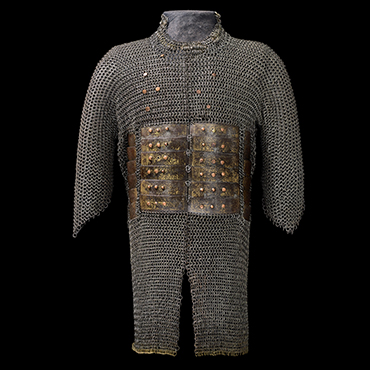Protection for a prince
Engraved at top of front right proper panel
On the order of the treasury of Abu al-Fath Ibrahim Sultan
This exceptionally well-preserved armor coat is the most significant of the few surviving Timurid examples. An inscription on the front upper right panel states that it was made for Ibrahim Sultan, a grandson of the Central Asian ruler Timur (r. AH 771-807/1370–1405 CE) and governor of Shiraz, Iran, from AH 816-38/1414-34 CE. Alongside his political role, Ibrahim Sultan was a great patron of the book arts and a skilled calligrapher in his own right. He is said to have copied five Qur’an manuscripts and to have prepared the inscriptions for two schools he founded. The floral design damascened in gold on the coat’s armor plates resembles the illuminated headings of two of Ibrahim Sultan’s surviving Qur’ans, dated AH 827/1424 CE and AH 834/1430–31 CE, suggesting a similar date for the armor. These patterns were almost certainly the product of the kitabkhana (design workshop) which Ibrahim Sultan, like other Timurid princes, would have maintained in his capital.
Mail armor was used from the early Islamic period onwards, sometimes combined with plates of metal, horn, or leather worn over the top. By the 9th century AH/15th century CE, mail and plate were combined to form the type of armor seen here; this is the earliest known piece that combines both techniques—perhaps one of the first produced by Timurid armorers. Although the exact origin of this new style of body armor is unknown, it was evidently popular, as it is used in all surviving later armors from the central Islamic lands in the medieval period. Ibrahim Sultan is known to have participated in a number of military expeditions.
Protection for a prince
Mail and plate armor coat
Bearing the name of Ibrahim Sultan
Probably Shiraz, Iran, c. AH 814–38/1420–34 CE
Steel, gold, h. 94 cm
Furusiyya Art Foundation, R-945

